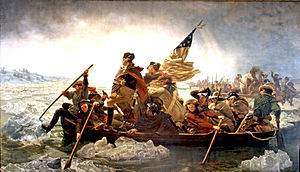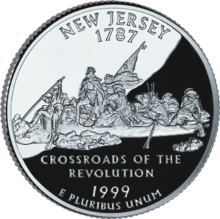- Washington Crossing the Delaware
-
This article is about the painting. For the poem, see Washington Crossing the Delaware (sonnet). For the actual event, see Washington's crossing of the Delaware River.
Washington Crossing the Delaware 
Artist Emanuel Leutze Year 1851 Type Oil on canvas Dimensions 378.5 cm × 647.7 cm (149 in × 255 in) Location Metropolitan Museum of Art, New York City Washington Crossing the Delaware is an 1851 oil-on-canvas painting by German American artist Emanuel Gottlieb Leutze. It commemorates General George Washington's crossing of the Delaware River on December 25, 1776, during the American Revolutionary War. That action was the first move in a surprise attack against the Hessian forces at Trenton, New Jersey in the Battle of Trenton.
The painting is part of the permanent collection of the Metropolitan Museum of Art in New York City. There are many copies of the painting, one of which is in the West Wing reception area of the White House.
Contents
History
German-born Emanuel Gottlieb Leutze (1816-1868) grew up in America, then returned to Germany as an adult, where he conceived of the idea for this painting during the Revolutions of 1848. Hoping to encourage Europe's liberal reformers through the example of the American Revolution, and using American tourists and art students as models and assistants, Leutze finished the first painting in 1850. Just after it was completed, the first version was damaged by fire in his studio, subsequently restored, and acquired by the Kunsthalle Bremen. In 1942, during World War II, it was destroyed in a bombing raid by the British Royal Air Force (which has led to a persistent joke that the raid was Britain's final retaliation for the American Revolution).
The second painting, a full-sized replica of the first, was begun in 1850 and placed on exhibition in New York in October 1851. More than 50,000 people viewed it. The painting was originally bought by Marshall O. Roberts for $10,000 (at the time, an enormous sum). After changing ownership several times, it was finally donated to the Metropolitan Museum of Art by John Stewart Kennedy in 1897.
The painting was loaned at least twice in its history. In the early 1950s, it was part of an exhibition in Dallas, Texas. Then, beginning in 1952, it was exhibited for several years at the United Methodist Church in Washington Crossing, Pennsylvania, not far from the scene of the painting. Today, it is on exhibition at the Metropolitan Museum of Art.
In January 2003, the painting was defaced when a former Metropolitan Museum of Art guard glued a picture of the September 11, 2001, terrorist attacks to it. No permanent damage was caused.[1]
Composition
The painting is notable for its artistic composition. General Washington is emphasized by an unnaturally bright sky, while his face catches the upcoming sun. The colors consist of mostly dark tones, as is to be expected at dawn, but there are red highlights repeated throughout the painting. Foreshortening, perspective and the distant boats all lend depth to the painting and emphasize the boat carrying Washington.
The people in the boat represent a cross-section of the American colonies, including a man in a Scottish bonnet and a man of African descent facing backward next to each other in the front, western riflemen at the bow and stern, two farmers in broad-brimmed hats near the back (one with bandaged head), and an androgynous rower in a red shirt, possibly meant to be a woman in man's clothing. There is also a man at the back of the boat that looks to be Native American.
The man standing next to Washington and holding the flag is Lieutenant James Monroe, future President of the United States. Also, General Edward Hand (commanding general at Siege of Yorktown) is shown seated and holding his hat within the vessel.
Historical inaccuracies
The painting contains an often-discussed historical inaccuracy: the flag borne in the painting is an anachronism.
The flag depicted is the original flag of the United States (the "Stars and Stripes"), the design of which did not exist at the time of Washington's crossing. The flag's design was specified in the June 14, 1777, Flag Resolution of the Second Continental Congress, and flew for the first time on September 3, 1777—well after Washington's crossing in 1776. The historically accurate flag would have been the Grand Union Flag, officially hoisted by Washington himself on January 2, 1776, at Cambridge, Massachusetts, as the standard of the Continental Army and the first national flag.
Artistic concerns motivated further deviations from historical (and physical) accuracy. For example, the boat (of the wrong model) looks too small to carry all occupants and stay afloat, but this emphasizes the struggle of the rowing soldiers. There are phantom light sources besides the upcoming sun, as can be seen on the face of the front rower and shadows on the water, to add depth. The crossing took place in the dead of night, so there ought to have been little natural light, but this would have made for a very different painting. The river is modeled after the Rhine, where ice tends to form in crags as pictured, not in broad sheets as is more common on the Delaware. (However, it is speculated that the Delaware River really was frozen over as depicted because of the Little Ice Age that was occurring at the time.)[citation needed] Also, the Delaware at what is now called Washington Crossing is far narrower than the river depicted in the painting. It was also raining during the crossing. Next, the men did not bring horses across the river in the boats. Finally, Washington's stance, obviously intended to depict him in a heroic fashion, would have been very hard to maintain in the stormy conditions of the crossing. Debunkers of the painting's historical accuracy have traditionally said that Washington would have been sitting down; historian David Hackett Fischer has argued, however, that everyone would have been standing up to avoid the icy water in the bottom of the boat (the actual boats used have higher sides).
In popular culture
- "Washington Crossing the Delaware" is also the title of a 1936 sonnet by David Shulman. It refers to the scene in the painting, and is a 14-line rhyming sonnet of which every line is an anagram of the title.
- William H. Powell produced a painting that owes an artistic debt to Luetze's work, depicting Oliver Perry transferring command from one ship to another during the Battle of Lake Erie during the War of 1812. The original painting now hangs in the Ohio Statehouse, and Powell later created a larger, more light toned rendering of the same subject which hangs in the U.S. Capitol in Washington, D.C. In both of Powell's works, Perry is shown standing in a small boat rowed by several men in uniform. The Washington painting shows the direction of travel from right to left, and the Perry image shows a reverse direction of motion, but the two compositions are still amazingly similar. Both paintings feature one occupant of the boat with a bandaged head.
- Washington Rallying the Troops at Monmouth, Leutze's companion piece to Washington Crossing the Delaware is displayed in the Heyns (East) Reading Room of Doe Library at the University of California, Berkeley.[2]
- In 1953 the American Pop Artist Larry Rivers painted his version of Washington Crossing the Delaware which is in the collection of The Museum of Modern Art in New York City.[3]
- Grant Wood makes direct use of Leutze's painting in his own Daughters of Revolution. The painting is a direct jab at the D.A.R., scrutinizing what Wood interpreted as their unfounded elitism.
- The painting is obtainable in the video game Animal Crossing as the "Classic Painting".
- Movie poster of Winnie the Pooh (2011) features the characters of Winnie and his friends in a honeypot, floating in honey. Tigger is the rower, with Winnie stylized as Washington.[1]
- Depicted by Solid Rock Baptist Church of Berlin, NJ in the 2011 Berlin 4th of July Parade Celebration.
- The painting is parodied in a comic strip of The Far Side by Gary Larson which depicts Washington and his troops in similar poses while merely crossing the street.
Censorship
At least three times in the 20th century, and as recently as 2002, American grade school administrators stepped in to alter textbook reproductions of the iconic painting because Washington's watch fob was painted too close to his crotch for their comfort, possibly resembling male genitalia. In Georgia in 1999, for example, Muscogee County teachers' aides painted out the timepiece by hand on 2,300 copies. And in Cobb County, Georgia, the page with the offending reproduction was completely torn out.[4][5]
References
Further reading
- Anne Hawkes Hutton, Portrait of Patriotism: Washington Crossing the Delaware. Chilton Book Company, 1975. ISBN 0-8019-6418-0. A detailed history of the painting, the actual crossing of the Delaware by American forces, and the life of Emanuel Gottlieb Leutze.
- David Hackett Fischer, Washington's Crossing. Oxford University Press, 2004. ISBN 0-19-517034-2. A detailed military history of George Washington's attack on Trenton; the introduction offers a close look at Leutze's painting.
External links
- Introduction to Washington's Crossing by David Hackett Fischer at the Oxford University Press blog.
- Errors in the painting from ushistory.org
Categories:- Works about the American Revolution
- Paintings of the Metropolitan Museum of Art
- Cultural depictions of George Washington
- New Jersey in the American Revolution
- Pennsylvania in the American Revolution
- 1851 paintings
Wikimedia Foundation. 2010.

